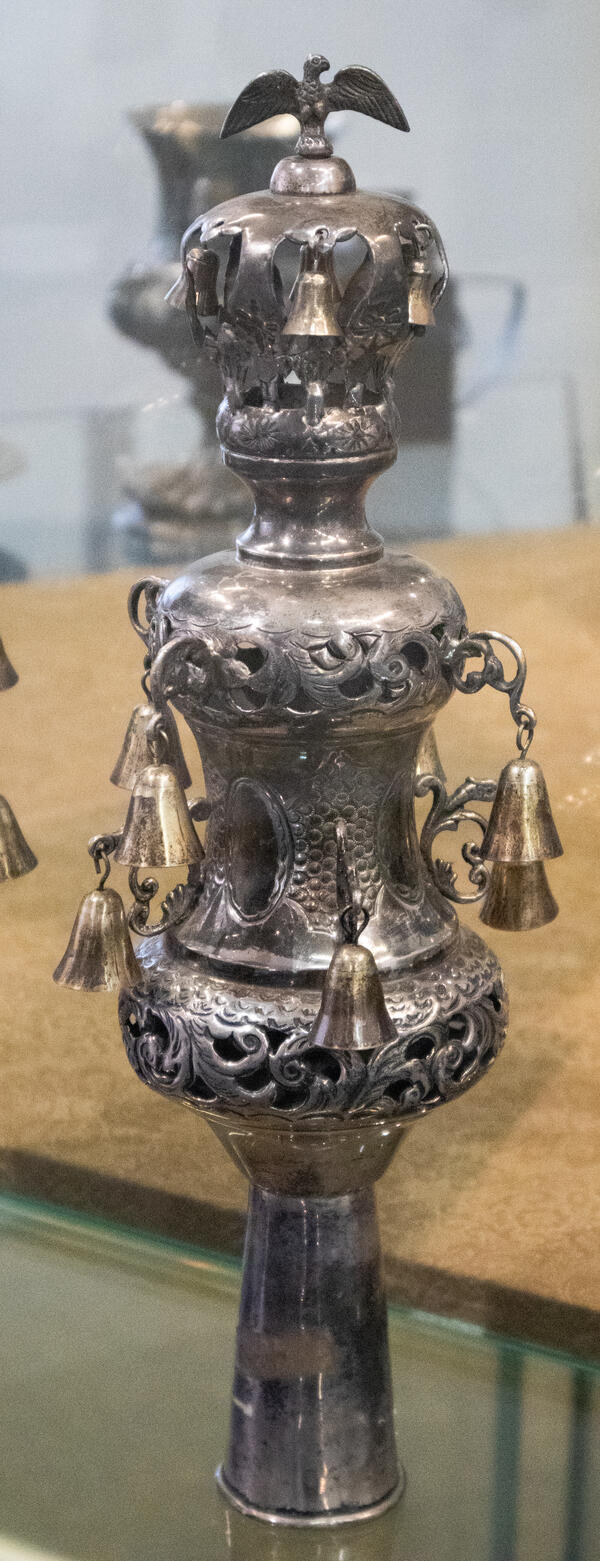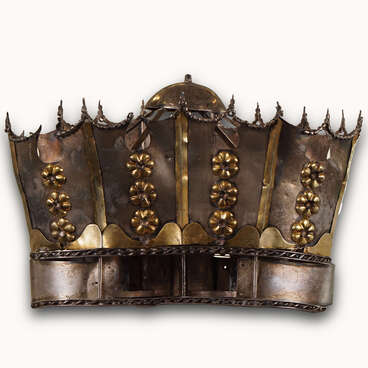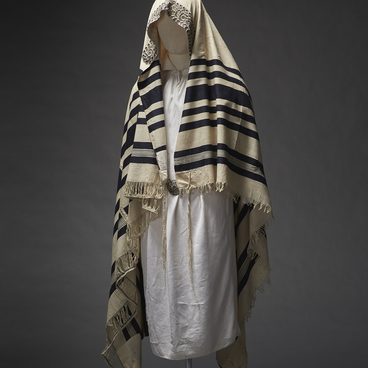The Torah scroll is a sacred parchment scroll with the hand-written text of the Pentateuch of Moses. It is used for public Torah reading in the synagogue and at home. It is one of the main sacred objects in Judaism, so it is surrounded by special rituals and paraphernalia.
The Torah Scroll is kept in the Aron Kodesh, the Ark of the Torah ark, which is covered with a special velvet curtain, the parokhet. It is forbidden to touch the Torah Scroll with bare hands, so it is enclosed in an ornate case decorated with velvet, gold embroidery and silver ornaments. All sacred objects in Judaism are to be elaborately decorated because beauty is a form of glorifying God. One such ornament is rimmonim.
“Rimmonim” literally translates from Hebrew as pomegranate fruit. It is a pair of finials for the Torah Scroll that crown the closed case. The term “rimmonim” originated in the 15th century, when the first pomegranate-shaped finials, one of the traditional symbols of Judaism and Israel, were made. Today the Torah crowns come in a wide variety of shapes, but the term “rimmonim” remains the same for all.
The ornaments are put on the upper ends of the handles, which are called the “tree of life”. Originally, the handles were decorated with engraving and covered with gold or silver foil. Later, to make it more practical, the ends of the handles were made spherical and called “tapukhim” — apples. Later, they became detachable and took the form of the rimmonim — pomegranates.
In the 17th century in Western and Southern Europe, Torah crowns were decorated with turrets, bell towers, suspended tiers and figures of lions, griffins and unicorns. In Central and Eastern Europe, the rimmonim still retained the traditional appearance of the pomegranate, which was only modernized by decorative elements and jewelry techniques for a long time.
Rimmonim in the form of tall cylinders with crowns, bells, tablets, and eagles developed in Eastern Galicia of the Austro-Hungarian Empire. When the Torah Scroll in full vestment was taken out of the synagogue ark and carried to the bimah, the podium from which it was read aloud during the service, the congregation heard the bells ringing and stood in homage.
The Torah Scroll is kept in the Aron Kodesh, the Ark of the Torah ark, which is covered with a special velvet curtain, the parokhet. It is forbidden to touch the Torah Scroll with bare hands, so it is enclosed in an ornate case decorated with velvet, gold embroidery and silver ornaments. All sacred objects in Judaism are to be elaborately decorated because beauty is a form of glorifying God. One such ornament is rimmonim.
“Rimmonim” literally translates from Hebrew as pomegranate fruit. It is a pair of finials for the Torah Scroll that crown the closed case. The term “rimmonim” originated in the 15th century, when the first pomegranate-shaped finials, one of the traditional symbols of Judaism and Israel, were made. Today the Torah crowns come in a wide variety of shapes, but the term “rimmonim” remains the same for all.
The ornaments are put on the upper ends of the handles, which are called the “tree of life”. Originally, the handles were decorated with engraving and covered with gold or silver foil. Later, to make it more practical, the ends of the handles were made spherical and called “tapukhim” — apples. Later, they became detachable and took the form of the rimmonim — pomegranates.
In the 17th century in Western and Southern Europe, Torah crowns were decorated with turrets, bell towers, suspended tiers and figures of lions, griffins and unicorns. In Central and Eastern Europe, the rimmonim still retained the traditional appearance of the pomegranate, which was only modernized by decorative elements and jewelry techniques for a long time.
Rimmonim in the form of tall cylinders with crowns, bells, tablets, and eagles developed in Eastern Galicia of the Austro-Hungarian Empire. When the Torah Scroll in full vestment was taken out of the synagogue ark and carried to the bimah, the podium from which it was read aloud during the service, the congregation heard the bells ringing and stood in homage.



